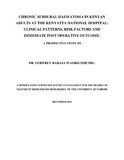| dc.description.abstract | Chronic Subdural haematoma (CSDH) is a collection of old blood between the
dura and the arachnoid membrane caused mostly by the tear of bridging veins. As a condition it
Presents a great disease burden with reported incidences ranging between 1.72 and 13.1 per
100,000 people1. The condition tends to afflict the elderly who suffer much larger bleeds due to the associated cerebral atrophy with increasing length of bridging veins3.
So the main aim of the study was to determine the clinical presentation, radiological patterns, risk factors and prognostic indicators for patients with chronic subdural hematoma seen in Kenyatta National Hospital.
Following ethical approval, 65 patients with CSDH who presented at KNH accident and emergency unit were consecutively recruited. Surgical intervention was two- burr-hole craniostomy without closed drainage system. Immediate postoperative outcome was done in the ward and then followed with post-discharge review at 2 weeks and one month at the neurosurgical outpatient clinics. Data was collected in pre-formed codified data sheets and analysis carried out using Statistical Package for Social Sciences (SPSS) version 17.0. Frequencies, means, median and interquartile ranges was computed for description of the various variables and presented in prose form and as pie charts and graphs. The association between categorical variables was calculated using Chi-square test while ANOVA was used for continuous variables.
In our study of the 65 patients,90.8% were men and elderly(29.2% in 7th decade,18.5% in 8th decade).The main clinical presentation was headache(83.1%)and confusion(72.3%) followed by neurological deficit(paresis 58.5%,aphasia 44.6%,loss of consciousness 43.1%).The main predisposing factors were trauma (70.7%) and alcohol intake (40%). Coagulopathy was only found in 13.8% and the rest of other known risk factors did not feature significantly. The most common radiological pattern was sub acute subdural(49.2%) followed by chronic (24.6%) with mean MLS of 6-15mm(84.6%),thickness of 10-20mm(56.9%)and volume of
>50mls(83.0%).Good outcome was seen in majority of the patient after intervention(89.2%).And in multivariate analysis of prognostic indicators, old age(p=0.178),use of anticoagulant(p=0.247) and preoperative GCS of ≤5(p=<0.0001)were the most significant. The volume of bleed, midline shift or thickness of haematoma did not have significant impact to the outcome. For post operative complication two patients(3.1%)had recurrence of which one was empyema(1.5%),Three(4.5%) had seizures and two (3.1%)died. Significant positive correlation was found between recurrence and coagulopathy(p=0.005)and radiological pattern(both patients had acute on chronic subdural haematoma)
In conclusion, the major risk factors for CSDH is male sex,trauma,old age and alcohol intake. Low preoperative Glasgow coma scale,coagulopathy and old age are major determinants of
poor outcome. Acute on chronic subdural haematoma and coagulopathy is associated with risk of recurrence. | en |
| dc.description.department | a
Department of Psychiatry, University of Nairobi, ; bDepartment of Mental Health, School of Medicine,
Moi University, Eldoret, Kenya | |

